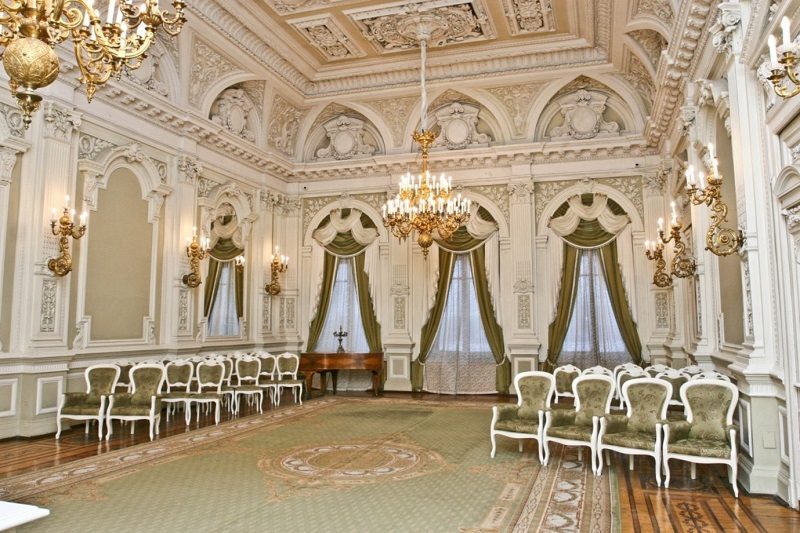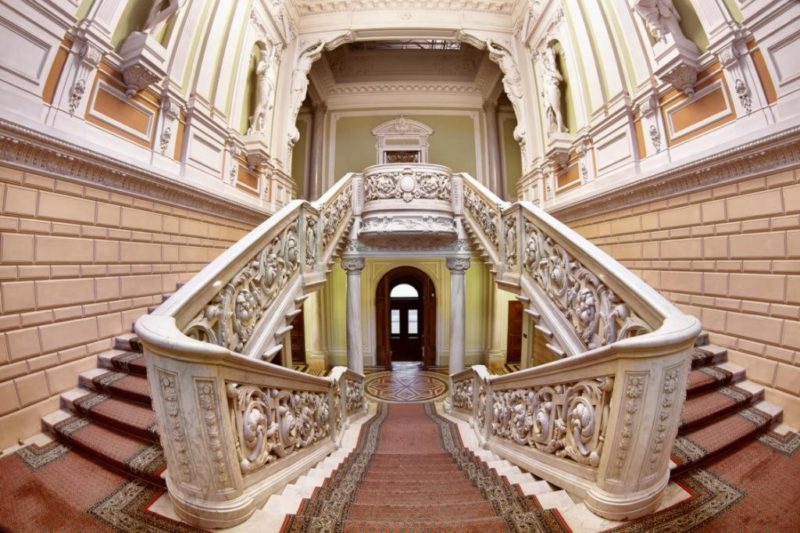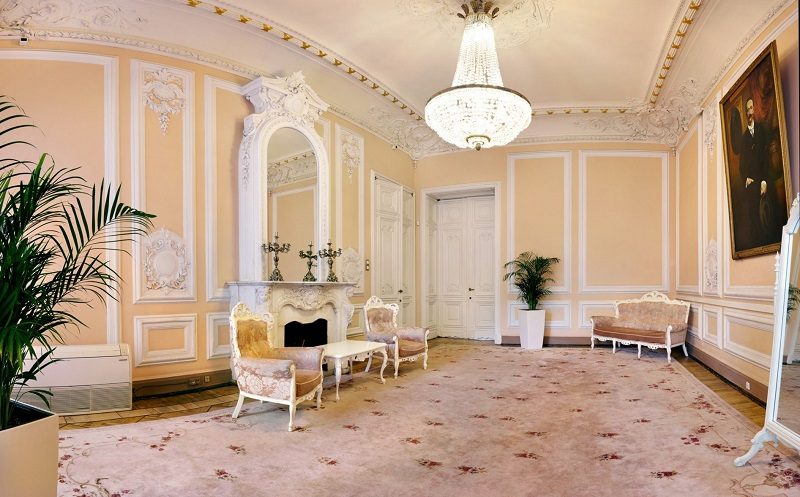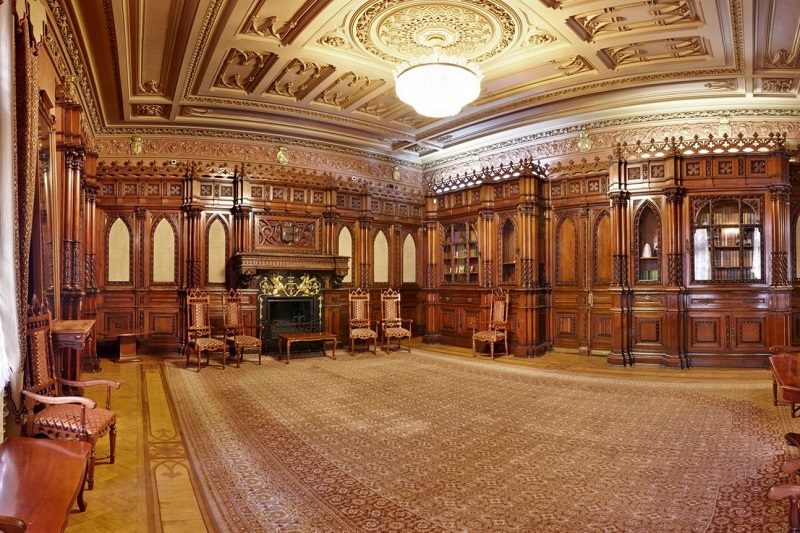Wedding Palace on the English Embankment
Address:
Saint Petersburg, Angliyskaya nab., 28
Working time:
Monday - Sunday: 10:00 - 14:00, 15:00 - 20:00, a break from 14:00 to 15:00

Wedding Palace/Dvorets Brakosochetaniya on the English Embankment/Angliyskaya Naberezhnaya, the mansion of P. P. von Derviz.
In the 1720s, this site on the English Embankment was owned by Major Ivan Polyansky. At the end of the 1730s, the stone two-storied house of the “for the famous” type project that belonged here belonged to his son Alexander. He was married to Catherine Romanovna Dashkova’s sister, Countess Elizaveta Romanovna.
In 1818, the house went to their distant relatives Vsevolozhsky. Nikita Vsevolodovich Vsevolozhsky, an official of the board of foreign affairs, a close friend of A. Pushkin, settled here. He inherited a great fortune from his father. But leading an extremely wasteful way of life was in great debt. In 1854 a house on the English Embankment was sold at auction for debt. Nikita Vsevolodovich wrote that the house was sold for a pittance.
Pavel Grigoryevich von Derviz, a nobleman, a builder of railways, the owner of a huge fortune, bought the Vsevolozhskiy mansion. Together with this house in 1883, he acquired the house number 34 on the English Embankment. After his death, house number 34 was inherited by the eldest son Sergey. At the end of the 1880s, the widow of Pavel Grigorievich Vera Nikolaevna wrote off house number 28 to her son Pavel and decided to rebuild it. For this, architect Alexander Fedorovich Krasovsky was invited. By that time, he had already built a lot for von Derviz.

It was then that the house von Dervizov received the Florentine facade. The architect planned the main rooms of the second floor around the main courtyard. The most spectacular suite of the Golden Lounge, the White/Belyy and the Dancey Hall came out onto the Neva. Here Krasovsky created the Mauritanian drawing room, a library in the style of the English Gothic. Among the living rooms on the mezzanine stands out the library in the style of the English Gothic.
The main staircase of the von Derviz's mansion is lit by a large stained glass window located above the fireplace. This fireplace has always had only a decorative value .. Earlier in its place was the work of the artist Konstantin Egorovich Makovsky. The library in this house is similar to the library in the Winter Palace/Zimny Dvorets. Krasovsky worked on them at about the same time.

The white hall/Bely Zal got its name due to the light decor of the walls, stucco ceiling and a large carved fireplace made of white marble, which was previously decorated with a mirror in a stucco frame. The lower part of the walls is covered with walnut panels. From the White door leads to the Yellow living room, whose windows overlook the courtyard. The room got its name due to the color of the walls. They harmonize well with the white stucco and graceful carved white Karrara marble fireplace. The largest and most elegant hall of the palace is the Dance Hall. Above the rich stucco cornice in the hall there were choirs for musicians. High mirrors in stucco frames alternate with fluted pilasters; in the center the hall was decorated with a picturesque canopy painted by KE Makovsky (now the canopy is lost). The ceiling of the Dance Hall, which we see today, was made according to a sketch by A. V. Treskin in 1959. Next to the hall was a small room in the Moorish style, the ceiling and walls of which were decorated with oriental ornaments. The residential premises of the owners were located in the mezzanine, on both sides of the main staircase. On the left side with the windows to the Neva there is the Blue drawing room, on the right - the Pompeii room, next to which there was a dining room and a library decorated in a pseudo-gothic style.

In March 1902, an exhibition of works of art and miniatures, organized by Empress Alexandra Fedorovna, was held at the house of von Dervizov. Later the exhibition moved to the Winter Palace/Zimny Dvorets.
In 1903, the son of the Grand Duke Vladimir Alexandrovich Andrey became the new owner of the mansion. Prince Andrei Vladimirovich later became known also thanks to his marriage to the famous ballerina Matilde Kshesinskaya. Apparently, he did not live in this house, but was located in a regimental apartment. But here gathered members of the royal family.
In 1918, Andrei Vladimirovich’s palace was nationalized. Various institutions worked here. During World War II, a children's receiver worked in the palace. Part of the premises occupied the hospital. After the war, a design organization and several other institutions worked here.
On November 1, 1959, by the decision of the Lensovet Soviet executive committee, the first Wedding Palace in the USSR was opened in the mansion. This function it performs today. Before the opening of the palace there was a large-scale restoration.
Read more
- How to travel in Saint Petersburg without living your home
- Four of the ten best restaurants in the country are in St. Petersburg
- The first Holocaust museum in St. Petersburg
- A scientist from St. Petersburg created the biochronicle of Peter the Great.
- 10 interesting facts about Saint-Petersburg streets